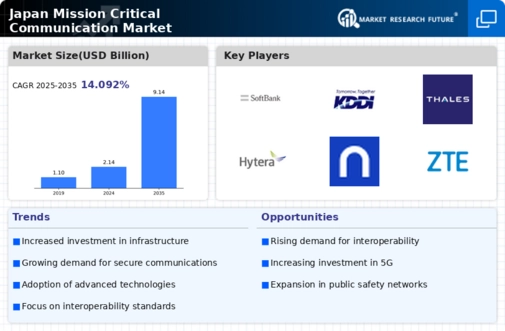Regulatory Compliance and Standards
The mission critical-communication market in Japan is heavily influenced by regulatory compliance and the establishment of industry standards. Government agencies are implementing stringent regulations to ensure that communication systems meet specific safety and reliability criteria. Compliance with these regulations is essential for organizations operating in sectors such as public safety, healthcare, and transportation. As of November 2025, it is anticipated that adherence to these standards will drive market growth by approximately 10%, as organizations invest in upgrading their communication infrastructure to meet regulatory requirements. This focus on compliance not only enhances operational reliability but also fosters public trust in emergency response systems.
Advancements in Communication Technology
The mission critical-communication market in Japan is experiencing a surge due to rapid advancements in communication technology. Innovations such as 5G networks and enhanced satellite communication systems are enabling faster and more reliable communication for emergency services. The integration of artificial intelligence and machine learning into communication systems is also enhancing decision-making processes during critical situations. As of 2025, the market is projected to grow at a CAGR of approximately 8.5%, driven by these technological advancements. This growth is crucial for ensuring that first responders and public safety officials can communicate effectively in emergencies, thereby improving response times and operational efficiency.
Increased Demand for Secure Communication
Security concerns are paramount in the mission critical-communication market, particularly in Japan, where data breaches and cyber threats are on the rise. Organizations are increasingly seeking secure communication solutions to protect sensitive information during emergencies. The demand for encrypted communication channels and secure data transmission is expected to grow significantly, with estimates suggesting a market increase of around 12% in the next few years. This heightened focus on security is likely to drive investments in advanced encryption technologies and secure communication protocols, ensuring that critical information remains confidential and protected from unauthorized access.
Collaboration Among Public and Private Sectors
Collaboration between public and private sectors is emerging as a vital driver in the mission critical-communication market. Partnerships between government agencies and private technology firms are fostering innovation and improving communication solutions for emergency services. These collaborations are likely to enhance the development of interoperable systems that can function seamlessly across different agencies. As of November 2025, it is estimated that such partnerships could lead to a market growth of approximately 11%, as they facilitate the sharing of resources and expertise. This collaborative approach is essential for creating robust communication networks that can effectively respond to emergencies and disasters.
Growing Urbanization and Infrastructure Development
Japan's rapid urbanization and ongoing infrastructure development are significant drivers of the mission critical-communication market. As urban areas expand, the need for efficient communication systems becomes increasingly critical for managing public safety and emergency response. The government is investing heavily in smart city initiatives, which include the integration of advanced communication technologies. This investment is projected to boost the mission critical-communication market by around 9% over the next few years. Enhanced communication infrastructure is essential for coordinating emergency services, managing traffic, and ensuring public safety in densely populated urban environments.






















Leave a Comment